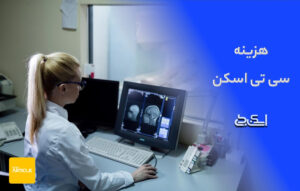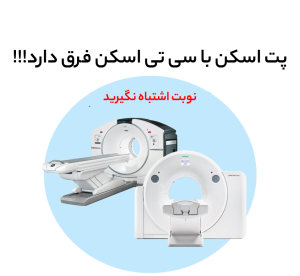سی تی اسکن
سی تی اسکن چیست؟
سی تی اسکن (Computed Tomography) یا مقطعنگاری رایانهای یا برشنگاری رایانهای یا توموگرافی، یکی از روشهای تصویربرداری پزشکی است که در علوم تشخیصی، تحقیقاتی و درمانی کاربردهای فراوانی دارد . در اسکن توموگرافی رایانه ای (اسکن CT یا CAT) از رایانه ها و دستگاه های اشعه ایکس چرخشی برای ایجاد تصاویر مقطعی از بدن استفاده می شود . این تصاویر اطلاعات دقیق تری نسبت به تصاویر اشعه ایکس معمولی ارائه می دهند . آنها می توانند بافت های نرم ، رگ های خونی و استخوان ها را در قسمت های مختلف بدن نشان دهند .
در سی تی اسکن، بدن یا اعضاء یا هر جسمی که از آن اسکن انجام میشود، به صورت لایهبهلایه اسکن میشود این تصاویر به صورت دوبعدی گرفته میشوند که با قرار دادن این تصاویر دوبعدی کنار یکدیگر تصویر سه بعدی ساخته میشود که با استفاده از این تصاویر پزشکان بخشهای درونی بدن یا جسم اسکن شده را میتوانند رؤیت کنند . در حین سی تی اسکن ، در حالی که قسمت داخلی دستگاه می چرخد و یک سری اشعه ایکس از زوایای مختلف می گیرد ، در دستگاهی شبیه تونل دراز می کشید . سپس این تصاویر به رایانه ارسال می شوند ، در آنجا با هم ترکیب می شوند و تصاویری از برشها یا مقطع بدن را ایجاد می کنند . آنها همچنین ممکن است برای تولید یک تصویر 3 بعدی از یک منطقه خاص از بدن ترکیب شوند .
سی تی اسکن ( CT Scan )، تصاویری از سطح مقطعهای مختلف، در عمق دلخواه از اعضای بدن را نشان میدهد . در رادیوگرافی معمولی اطلاعات مربوط به عمق از دست میرفت . از طرفی نمیتوانست بین نسوج نرم تمایز ایجاد کند . طبعاً اطلاعات کمی مربوط به چگالی بافتها را نیز، در احتیارمان نمیگذاشت . در مقطع نگاری معمولی مشکل اول، یعنی تصویربرداری از یک مقطع دلخواه حل شد، ولی مقطع نگاری کامپیوتری دو مشکل دیگر رادیوگرافی معمولی را نیز حل کرد . یعنی حساسیت مورد نیاز برای تمایز بین نسوج نرم را دارا میباشد، همچنین اطلاعات کمی در مورد میزان تضعیف (ناشی از عبور اشعه از نسوج) را نیز میدهد . البته در این روش قدرت تفکیک بهبود نیافته و تنها بخشهای ناخواسته ، تارتر میشوند .
تاریخچه سی تی اسکن:
قبل از توضیح جامعتر در مورد سی تی اسکن ( CT Scan) لازم است تا تاریخچه ای از تیوب اشعه ایکس ذکر کنیم . در سال 1895 اشعه ایکس توسط ویلیام رونتگن کشف شد . در آن زمان ، دانشمندان مختلفی در حال بررسی حرکت الکترون ها با استفاده از یک تیوب شیشه ای بنام تیوب کروکز ( Crookes Tube ) بودند . رونتگن می خواست عملکرد الکترون ها را به تصویر بکشد ، بنابراین او لوله کروکز خود را با کاغذ عکاسی سیاه پیچید . وقتی او آزمایش را شروع کرد، متوجه شد که آن صفحه عکاسی سیاه با مواد فلورسنت پوشانده شده است . این اتفاق کاملا غیر منتظره بود زیرا هیچ نور مرئی در اتاق وجود نداشت تا این عمل در اثر آن بوجود آمده باشد و همچنین از تیوب کروکز نیز نوری مرئی ساطع نشده بود . رونتگن با تحقیقات بیشتر ، متوجه شد که واقعاً نوعی نور نامرئی توسط تیوب کروکز ( Crookes Tube ) تولید می شود و می تواند به مواد مختلف مانند چوب ، آلومینیوم یا پوست انسان نفوذ کند . این آزمایش مقدمه ای و شروعی برای ساخت نسلهای مختلف سی تی اسکن در آینده شد.
سی تی اسکن ( CT Scan ) ، روش تلفیق استفاده از توموگرافی معمولی(مقطع نگاری) با پردازشهای کامپیوتری میباشد . در روش تصویربرداری با سی تی اسکن از اشعه X استفاده میشود . البته دوز مورد استفاده در این روش بسیار بالاست و تفاوتهای ساختاری ای مثل استفاده از حرکت لامپ تولید کننده اشعه ایکس (تیوب سی تی اسکن) و یا حرکت آشکارساز، همچنین گاهی آشکارسازهای حلقوی دور بیمار و …، با رادیوگرافی معمولی دارد .
اسکنر مغز EMI ، نصب شده در بیمارستان آتکینسون مورلی ، ویمبلدون در سال 1971 ، توسط EMI ،Hayes ، Middlesex نخستین دستگاه سیتی اسکن تجاری نصب شده در جهان میباشد . این اسکنر مغز ، طراحی شده توسط گادفری هونسفیلد در EMI ، اولین مدل تولیدی بود که اولین آزمایشات روی بیماران را در سال 1971 انجام داد . این اسکن به عنوان یک فناوری اصلی تصویربرداری ، به ویژه برای مغز ایجاد کرد . ورود سی تی اسکن به تجهیزات پزشکی یک موفقیت بزرگ و فراموش نشدندی بود، به طوریکه تا سال 1977، 1130 دستگاه سی تی اسکن در سراسر جهان نصب شد . این روش همچنان رایج است و یکی از پیشگامان تصویربرداری پزشکی در جهان شناخته شده است، با این وجود بعد از سی تی اسکن فناوری های جدیدتری مانند تصویربرداری با تشدید مغناطیسی (MRI) اکنون برای بسیاری از کارهای تشخیصی که قبلاً به CT اختصاص داده شده بود ، استفاده می شود.
پایههای ریاضی مقطعنگاری کامپیوتری به اوایل قرن بیستم باز میگردد . کاربرد عملی این روش در دهه ۶۰ میلادی بنیانگذارده شد . در سال ۱۹۶۳، آلن کرماک از دانشگاه تافتز از افرادی بود که نخستین بار نظریه یک سیستم سی تی اسکن را مطرح کرد . اما عملاً اولین اسکنر تجارتی در سال ۱۹۷۲ توسط گودفری هاونسفیلد از آزمایشگاه EMI در انگلستان انجام گردید.
یکای هاونسفیلد (Hounsfield Units) واحد هاونسفیلد یا شمارههای سی تی، به افتخار هاونسفیلد نامگذاری گردید واحدی است که در مقطع نگاری کامپیوتری مورد استفاده قرار میگیرد، این یکا را به صورت مختصر با HU نمایش میدهند که به افتخار گودفری هاونسفیلد نام گذاری گردیده است. با توجه به تلاشهای صورت گرفته توسط کرماک و هاونسفیلد در راستای ابداع سیستم سی تی اسکن جایزه نوبل پزشکی در سال ۱۹۷۹ به آنها اعطا گردید.
در مورد بررسی تاریخچه دستگاههای سی تی اسکن میتوان تکامل این سیستمها به صورت هفت نسل مختلف این دستگاهها مورد بررسی قرار داد.
چرا سی تی اسکن انجام می شود؟ کاربردهای سی تی اسکن:
در حال حاضر سالیانه بیش از 75 میلیون اسکن سی تی در آمریکا انجام میشود . بر اساس تخمین یکی از نشریههای معتبر آمریکایی ۲٪ سرطان ها(نوع بدخیم) ناشی از دوز بالای استفاده شده در سی تی اسکن است . تلفیق دو روش PET و CT که تحت عنوان PET/CT شناخته شده است ، روش جدیدی ست که در آن اطلاعات مربوط به آناتومی که از تصاویر سی تی اسکن قابل تشخیص است، با اطلاعات متابولیکی (با استفاده از تصاویر پت اسکن) که مربوط به عملکرد و اجزا میباشند، تلفیق شده و روشی مطلوب بخصوص در مطالعه تومورها میباشد . نکته حائز اهمیت، عدم ضرورت استفاده از دوز بالای CT در این روش است . این روش ۸۵٪ در مطالعه تومورها (تشخیص سلولهای بدخیم از خوش خیم، مشاهده دقیق روند پیشروی سلولهای سرطانی و بررسی پاسخ به درمان و رادیوتراپی)، ۱۰٪ در نورولوژی ،۵٪ در مطالعات قلب، استفاده میشود .
سی تی اسکن کاربردهای زیادی دارد ، به ویژه برای تشخیص بیماری ها و ارزیابی آسیب ها بسیار مناسب است . این روش تصویربرداری پزشکی می تواند به پزشک شما کمک کند تا:
-
-
- عفونت ها ، اختلالات عضلانی و شکستگی استخوان را تشخیص دهد
- محل توده ها و تومورها (از جمله سرطان) را تعیین کند
- رگهای خونی و سایر ساختارهای داخلی را مطالعه کند
- میزان آسیب های داخلی و خونریزی داخلی را ارزیابی کند
- جراحی ها و نمونه برداری ها را راهنمایی کند
- نظارت بر اثربخشی درمان ها برای برخی از شرایط پزشکی ، از جمله سرطان و بیماری های قلبی ندول های ریوی و توده کبد را انجام دهد .
-
تصویربرداری پزشکی با سی تی اسکن تقریبا غیرتهاجمی است و می تواند به سرعت انجام شود .
از کاربردهای عمده دستگاه سی تی اسکن میتوان به عناوین زیر اشاره کرد:
-
-
-
-
- سی تی اسکن گردن
- سی تی اسکن مغز (سی تی اسکن سر)
- سی تی اسکن سینوس ها
- سی تی اسکن ریه
- سی تی اسکن شکم
- سی تی اسکن ستون فقرات
- سی تی اسکن تروما
- سی تی اسکن قلب
- سی تی اسکن عروق
- سی تی اسکن زانو
- سی تی اسکن سینه
-
-
-
سی تی اسکن چگونه انجام می شود؟
سی تی اسکن ( Computed Tomography scan )، یکی از مودالیته های تصویربرداری پزشکی میباشد که برای ایجاد تصاویر مقطعی یا برشی از بدن توسط رایانه با استفاده از دستگاه های چرخش اشعه ایکس می باشد.
سی تی اسکن با ارسال چندین پرتوی اشعه ایکس در زوایای مختلف کار می کند ، به طوری که با تابش این اشعه ها به بدن بیمار تصویری به صورت سه بعدی توسط یک کامپیوتر تشکیل میشود.
تصاویر اطلاعات دقیق تری نسبت تصاویر عادی اشعه ایکس ارائه می دهند آنها می توانند بافتهای نرم ، رگهای خونی و استخوانها را در قسمت های مختلف بدن نشان دهند .
در واقع اسکن توموگرافی کامپیوتری یا سی تی اسکن مجموعه ای از تصاویر اشعه ایکس را که از زوایای مختلف در اطراف بدن فرد گرفته شده است ، ترکیب نموده و با استفاده از کامپیوتر تصاویر مقطعی یا برشی از استخوان ها ، رگ های خونی و بافت های نرم مانند ریه و مغز در بدن را بسازد.
تکنولوژی سی تی اسکن در ادامه مسیر رادیولوژی باعث شد تا پزشکی و مسیر درمان به طور چشمگیری متحول شود. با استفاده از این روش، پزشکان به راحتی توانستند بیماری هایی که در گذشته اغلب در جراحی یا کالبد شکافی دیده می شدند را ببینند و در مسیر درمان و تشخیص راحتتر و سریعتر اقدام نمایند.
پیشرفتهای روزافزون دستگاههای سی تی اسکن، با عبور از نسلهای مختلف این دستگاه ها آنچنان بوده است که میتوانند تصاویری با برش های با فاصله کمتر از یک میلیمتر را از بدن انسان تهیه کنند.
به طور کلی انجام سی تی اسکن به دو صورت بدون تزریق و با تزریق ماده حاجب صورت میپذیرد، با توجه به تشخیص پزشک ممکن است یک ماده مخصوص که به ماده حاجب معروف است به بیمار داده شود تا بتوان اجزای مختلف بدن را با وضوح بیشتری در تصاویر اشعه ایکس تشخیص داد. ماده حاجب با توجه به ماهیتی که دارد اشعه ایکس را در خود مسدود می کند و باعث میشود تصویر آن روی تصاویر سی تی اسکن به صورت سفید دیده شود این موضوع باعث میشود تا عضوی که به آن ماده حاجب داده شده است مانند روده ها ، رگ های خونی یا سایر عضوهای مورد بررسی از بقیه اعضای دیگر کاملا قابل تشخیص شوند. بسته به بخشی از بدن که مورد بررسی قرار می گیرد ، ممکن است لازم باشد بیمار مایعی حاوی ماده حاجب بنوشد . همچنین ممکن است لازم باشد که ماده حاجب از طریق تزریق به بازو یا مقعد از طریق راست روده تجویز شود . اگر پزشک شما قصد استفاده از ماده حاجب را دارد ، ممکن است قبل از سی تی اسکن از شما بخواهد چهار تا شش ساعت قبل از انجام اسکن ناشتا بگیرید .
آمادگی برای انجام سی تی اسکن:
هنگام انجام سی تی اسکن ، از بیمار خواسته می شود که لباس مخصوص بیمارستانی (گان) پوشیده و اشیا فلزی در صورت جداشدن از خود جدا کند و بیرون اتاق اسکن و به همراه خود تحویل دهد. چون فلز می تواند روی تصاویر سی تی اسکن و همینطور در نتایج سی تی اسکن تداخل ایجاد کند . این اقلام میتواند شامل جواهرات ، عینک و دندان مصنوعی است . سپس کارشناس دستگاه سی تی اسکن یا همان اپراتور دستگاه، از بیمار می خواهد که روی تخت دستگاه دراز بکشد ، تا آمادگی بیمار توسط کارشناس تکمیل گردید ، کارشناس دستگاه از اتاق اسکن خارج می شود و به اتاق کنترل می رود تا بتوانند اسکن را شروع کند، در تمام مدت اسکن اپراتور دستگاه سی تی اسکن اشراف کامل به بیمار دارد و میتوانند حرکت بیمار را ببیند و حتی صدای بیمار را بشنوند .
در زمان شروع اسکن، بیمار توسط تختی که روی آن دراز کشیده است به آرامی داخل حفره ( گنتری ) دستگاه سی تی اسکن هدایت میشود ، دستگاه اشعه ایکس به دور بیمار شروع به چرخش کرده و در عمل اسکن بیمار شروع میشود. در هر چرخش گنتری دستگاه تصاویر بی شماری بسته به تنظیمات و نوع اسکن از برشهای نازک بدن بیمار تولید میشود . بیمار در حین اسکن صدای چرخش و بوق ها مرتبط به تابش اشعه ایکس ( اکسپوز ) را میشنود . همزمان تخت بیمار به داخل یا بیرون گنتری براساس مرحله اسکن یا نوع اسکن چند میلی متر حرکت می کند تا اسکن به درستی انجام گیرد . کل مراحل از زمان ورود بیمار به اتاق اسکن تا خروج ممکن است بین 10 دقیقه تا حتی یک ساعت طول بکشد .
نکته بسیار مهمی که ممکن است در زمان انجام اسکن اپراتور از بیمار بخواهد تا انجام دهد، عدم حرکت در حین اسکن میباشد. در طول اسکن با CT ، بدون حرکت بودن بیمار بسیار مهم است زیرا حرکت می تواند منجر به تار شدن تصاویر شود که در بعضی موارد نیاز به تکرار اسکن و دریافت دوز بیشتری از اشعه گردد . همچنین ممکن است اپراتور دستگاه از شما بخواهد در طول اسکن برای مدت کوتاهی نفس خود را نگهدارید تا از بالا و پایین رفتن قفسه سینه جلوگیری کند . اگر اسکن از کودک خردسال نیاز باشد ، ممکن است پزشک داروی آرامبخش را برای جلوگیری از حرکت کودک توصیه کند .
پس از اتمام سی تی اسکن ، تصاویر برای معاینه به رادیولوژیست ارسال می شود .
نتایج سی تی اسکن به چه معناست؟
اگر رادیولوژیست تومور ، لخته شدن خون ، شکستگی یا سایر ناهنجاری ها در تصاویر را مشاهده نکند ، نتایج CT اسکن طبیعی تلقی می شود . اگر در هنگام سی تی اسکن هرگونه ناهنجاری تشخیص داده شود ، بسته به نوع ناهنجاری یافت شده ، ممکن است به آزمایشات یا درمان های بیشتری نیاز داشته باشید .
آیا سی تی اسکن دارای عوارض میباشد؟
همانطور که ذکر شد اساس کار سی تی اسکن با اشعه ایکس میباشد و در طول سی تی اسکن بیمار در معرض تابش های یونیزه شده و اشعه ایکس قرار می گیرید . این مقدار تابش بیشتر از مقدار تابشی است که شما از اشعه ایکس دستگاه رادیولوژی دریافت می کردید به همین دلیل است که در سی تی اسکن اطلاعات مفصل تر و دقیق تری بدست می آید .
تاکنون از سی تی اسکن اثرات و آسیب های بلند مدت نشان داده نشده است اما احتمال بسیار اندکی برای افزایش خطر ابتلا به سرطان در آن وجود دارد . اما بایستی دقت شود که در قبال این خطرات کوچک چه چیزی بدست می آوریم، انجام سی تی اسکن مزایای بسیاری را در اختیار ما قرار میدهد لذا به همین دلیل می توان از خطرات ذکر شده که قابل چشم پوشی میباشد صرفنظر کرد . معمولا پزشکان و همچنین مراکز تصویربرداری پزشکی تا جایی که ممکن است از مقدار تابش اندکی برای تعیین و تشخیص اطلاعات پزشکی مورد نیاز خود استفاده می کنند .
شرکتهای مختلفی در تولید دستگاههای سی تی اسکن در سراسر دنیا فعالیت دارند که یکی از مزایای رقابتی این کمپانیها تولید دستگاههایی بروزتر و با تکنولوژی هایی با تابش دهی کمتر نسبت به مدلهای قدیمی تر میباشد، در این دستگاهها از تکنیکها و تکنولوژیهایی استفاده می کنند که به تابش کمتری نیاز باشد .




























